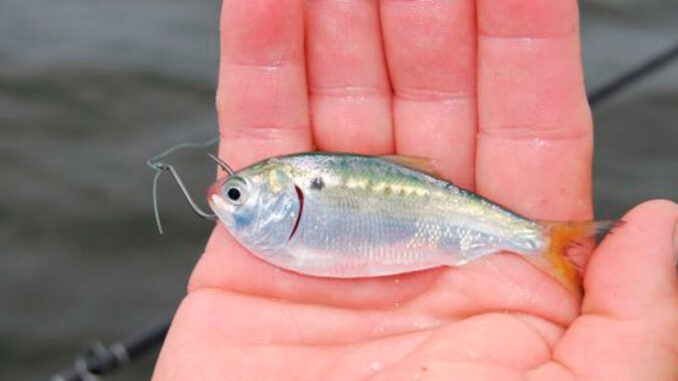
The assembled commercial fishermen outside state Wildlife and Fisheries headquarters Feb. 1 apparently had a huge influence on the fate of the next hotly debated fishery issue confronting Louisiana.
These men, more than 50 of them, fish menhaden.
Menhaden – pogies – was, and remain, the issue.
To the point, it was the notice of intent to push these men and their controversial operations at least one mile off Louisiana’s coast. In some cases, like Grand Isle and Rutherford/Holly Beach, it’s a barrier of three miles.
The Advocate/The Times ran a story about the more than 40 spills of dead fish attributed to the practice of netting pogies along our coast — just since 2020.
When the bosses of the two foreign-owned pogie fishing companies operating in Louisiana waters used more than 30 minutes to explain how they were taking steps to upgrade their nets, and the economic hardship associated with moving their operations to one-mile off our coastline, there were few hard-in-fact questions coming from the six Louisiana Wildlife and Fisheries Commission members who showed up for this all-important vote.
Can’t take the steps
Knowing this isn’t the easiest story to read in this month’s Sportsman, it’s even harder to try to understand why these six folks couldn’t take the steps needed to restrict this fishery.
Fact No. 1: Louisiana is the only state allowing this almost unrestricted access to our waters.
Fact No. 2: The pogie season is set April 15-Nov. 1 annually.
Fact No. 3: The commercial take of pogies number anywhere from 800 million pounds to 1 billion pounds annually.
Let’s start with No. 3; pogies are a small fish, a forage fish for most of the predator species recreational fishermen like to catch, and spend millions upon millions of dollars in our state to catch — annually. We’re talking here about speckled trout and redfish, species targeted for recreational fishing catch last year (speckled trout daily creel reduced by 40%) and this year (redfish proposed creel by 40% and slot limits reduced, too).
If these small pogies average 4 ounces, and they take 800 million pounds, that means 3.2 billion pogies are taken from state waters — annually. If the average weight is heavier, then the total number of pogies is less, but still in the billions.
Stands to reason
Stands to reason taking billions of anything from our waters affects something, surely including the reduction in the food for struggling predator species like redfish and speckled trout that we mentioned above.
There’s more, much more.
Folks new to this menhaden discussion, again apparently including a couple of our Wildlife and Fisheries Commission members, who seemingly knew nothing about the issue, see only those spill reports of the last four years.
Fact is, I’ve been fishing our coast for the last 40 years, and Grand Isle for the last 58 years. There were dead fish then, a few from shrimpers but mostly from what menhaden operations we saw along Elmer’s Island, west into East Timbalier and farther west to south of Cocodrie.
So, spills didn’t just start 4 years ago.
That’s the problem. This isn’t some recent phenomenon, these dead fish, this disruption of the fragile Gulf food chain.
And, when menhaden folks show up to a meeting to protest moving their operation farther off the coastline, it’s not simply a punitive reaction to recent spills, it’s a combination of more folks paying attention to a long-standing commercial fish-catching operation.
This is a shallow-water commercial fishery, one that places nets in places where speckled trout, redfish, black drum, Spanish mackerel and other species are there feeding and spawning, because that’s where there is food to eat — pogies
For years, this commercial fishery, most times with the blessing of state Wildlife and Fisheries, have insisted the bycatch of this operation was “relatively insignificant.”
Oh?
Commercial net fishing always has struggled with bycatch, the taking of other unintended species. What has changed since 2020 is folks are counting bycatch, and don’t like dead redfish showing up on their beaches, especially in light of reducing sports fishing limits because the fish are struggling.
Telling numbers
That leaves three salient points:
First, if the bycatch is 1% (a number they say is “insignificant”) then that’s 8 million pounds of bycatch. Redfish. Speckled trout. Other sports fish. If it’s 2%, then that’s16 million pounds on an 800 million-pound annual haul.
Second, if the annual recreational catch of speckled trout and redfish is estimated at 3 million pounds each, then, by count, 6 million total is less than 8 million and far less than a maybe more accurate 16 million.
Third, the reason for the commercial operation opposition is catching menhaden in shallow water along Louisiana’s coast is easy, and pushing fishing grounds out to one mile will make it tougher to provide income for, remember this, two foreign-owner companies employing only-they-know-how-many Louisiana workers.
Originally, the commission pushed the vote on this notice to March 7, then suddenly called an emergency meeting on Feb. 15 where a “compromise” agreement had been worked out. You can read details in this edition’s Outdoor Update.
Fact is, the reason catching pogies has become such a hot-button item is we have more recreational fishermen than we had 40 years ago, and more eyes are seeing what is left in the wakes of pogie boats operating in shallow water.
And, know what, more eyes means more concern and more outrage and explains why all the other states along the Atlantic seaboard and four of the five Gulf States have imposed much stricter restrictions on the menhaden fishery.